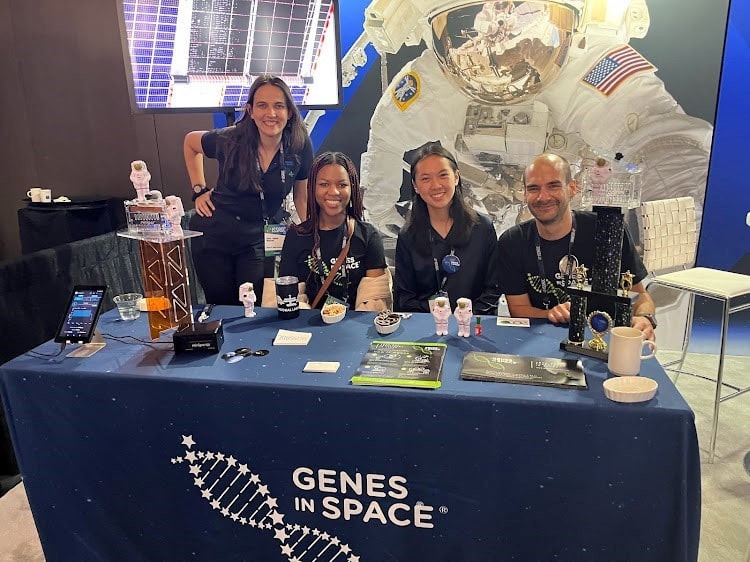Aerospace
Boeing, Partners Announce Next Student-Designed Experiment Bound for International Space Station

The winner of this year’s Genes in Space competition, a biology-based research contest sponsored by Boeing, is 17-year-old Isabel Jiang. The announcement was made in Seattle during the International Space Station Research and Development Conference. Next year, astronauts working out of the U.S. National Laboratory on board the International Space Station will conduct Jiang’s experiment.
Students in grades 7 through 12 are encouraged to create biological experiments for the Genes in Space competition that address practical issues in space travel. 194 schools from 31 states submitted work for the national competition. At the conference, the authors of the top five proposals discussed their concepts with a group of academics, technologists, and scientists.
From a competitive field of 820 entries from 1,177 students, Jiang’s experiment was chosen. Her research aims to comprehend the processes that lead to the reactivation of dormant viruses in outer space.
I’m eager to observe the results of [my experiment] in space and utilize that knowledge to guide future medical choices, said Jiang.
Virgin Galactic brings commercial space to the Dubai Airshow(Opens in a new browser tab)
She added that she is eager to investigate a subject that has not previously been researched in space and to see how her findings will be used in medicine here on Earth.
Jiang’s study, together with two programme technology demonstration trips, will be the eleventh Genes in Space student experiment carried out by astronauts aboard the International Space Station. In 2015, Genes in Space was established as a result of a partnership between Boeing and miniPCR bio. Since then, the programme has been supported by the ISS U.S. National Laboratory and New England Biolabs.

Aerospace
Boeing Transfers Rocket Stage to NASA, Paving Way for Human Moon Mission

Boeing has achieved a significant milestone by providing NASA with the second core stage of the Space Launch System (SLS) rocket.
This crucial component, crafted at NASA’s Michoud Assembly Facility (MAF), is set to propel the Artemis II crew into lunar orbit, marking humanity’s return to deep space after a 50-year hiatus.
The monumental Boeing-built rocket stage, the largest element of the Artemis II mission, will embark on a journey aboard the Pegasus barge, traveling 900 miles to NASA’s Kennedy Space Center.
Comparison of two legendary aircraft B777x vs B747 aircraft:Click here
Upon arrival, it will be meticulously integrated with other essential Artemis II components, including the upper stage, solid rocket boosters, and NASA’s Orion spacecraft within the iconic Vehicle Assembly Building. This intricate integration process is a vital step toward the eagerly anticipated Artemis II launch, slated for 2025.
“Boeing-built products helped land humankind on the moon in 1969, and we’re proud to continue that legacy through the Artemis generation,” remarked Dave Dutcher, vice president and program manager for Boeing’s SLS program. “Together, with NASA and our industry partners and suppliers, we are building the world’s most capable rocket and paving the way to deep space through America’s rocket factory in New Orleans.”
NASA, Lockheed Martin Reveal X-59 Quiet Supersonic Aircraft:Click here
The delivery of Core Stage 2 marks a significant achievement in the evolution of the SLS rocket. Towering over 200 feet and powered by four RS-25 engines, this core stage, coupled with two solid-fueled booster rockets, will generate a staggering 8.8 million pounds of thrust. This immense power is crucial to launching Artemis II and future missions into the vast expanse of space.
The SLS rocket stands unparalleled in its capability to transport both crew and substantial cargo to the moon and beyond in a single launch. Its extraordinary capacity will facilitate the delivery of human-rated spacecraft, habitats, and scientific missions to destinations including the moon and Mars, ushering in a new era of space exploration.
-

 Travel1 week ago
Travel1 week agoAir India to Expand US Operations with Three New Routes After a Decade
-

 Travel2 weeks ago
Travel2 weeks agoWhy We Should Avoid These Stamps in a Passport
-

 Airlines1 month ago
Airlines1 month agoInvestigations Reveal Fake Chinese Titanium in Boeing and Airbus Jets
-

 Tech4 weeks ago
Tech4 weeks agoChina’s CATL Plans 1,800-Mile Electric Plane Launch by 2027
-

 Airport3 days ago
Airport3 days agoTop 10 Largest Airports in the World by Size
-

 Aerospace4 weeks ago
Aerospace4 weeks agoChina’s Fighter Jets Turn Wings into Autonomous Drones
-

 Airlines4 days ago
Airlines4 days agoAir India Rolls Out A350s for Delhi-New York JFK and Newark Routes
-

 Defence3 weeks ago
Defence3 weeks agoBoeing Enhances Chinook with New Engines and Block II Upgrades at $96 Million







